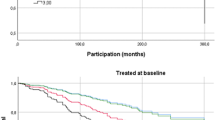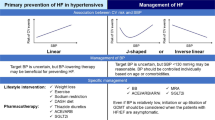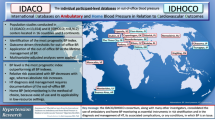Abstract
Elevated blood pressure (BP) is probably the most-important modifiable risk factor for cardiovascular disease (CVD). BP influences the development of CVD, even if levels of BP are well below the usual cut-off point that defines the presence of arterial hypertension. Adequate measurement of BP is the most-important requirement for the diagnosis and treatment of patients with suspected hypertension. The use of methodologies such as ambulatory and home BP monitoring have become powerful tools for defining the 'real' BP of patients, discarding the white-coat effect, and discovering masked hypertension. Early intervention with life-style changes and antihypertensive drugs is required to obtain the best outcome for the patient. In this sense, early use of combination antihypertensive drug therapy is recommended. The treatment of resistant hypertension—the type of elevated BP that is most difficult to control—has clearly improved over the past decade. Further studies are required to define how antihypertensive therapy should be used in the earliest stages of hypertension and for the treatment of patients with a mild-to-moderate increase in global cardiovascular risk.
Key Points
-
Half of the burden of cardiovascular disease (CVD) in the general population is attributable to high blood pressure (BP); the threshold BP for the initiation of antihypertensive treatment is currently 140/90 mmHg
-
CVD and renal disease often develop in parallel in the cardiovascular continuum, and control of BP is required at all stages of this continuum to improve patient outcome
-
A BP goal of <130/80 mmHg could represent a risk for patients with coronary artery disease, but might be considered for patients with proteinuria or those at high risk of stroke
-
The prompt use of combination antihypertensive drug therapy facilitates initial BP control; patient compliance and treatment adherence improve BP control during therapy
-
Resistant hypertension continues to occur frequently, although BP control has improved with the use of aldosterone blockers and techniques such as renal denervation and baroreceptor stimulation
-
New studies, particularly of the early stages of arterial hypertension, are required and a more-frequent use ambulatory and home BP measurements is recommended
This is a preview of subscription content, access via your institution
Access options
Subscribe to this journal
Receive 12 print issues and online access
$209.00 per year
only $17.42 per issue
Buy this article
- Purchase on Springer Link
- Instant access to full article PDF
Prices may be subject to local taxes which are calculated during checkout

Similar content being viewed by others
References
Lawes, C. M., Vander Hoorn, S., Rodgers, A. & International Society of Hypertension. Global burden of blood-pressure-related disease, 2001. Lancet 371, 1513–1518 (2008).
Lewington, S., Clarke, R., Qizilbash, N., Peto, R. & Collins, R. Age-specific relevance of usual blood pressure to vascular mortality: a meta-analysis of individual data for one million adults in 61 prospective Studies. Lancet 360, 1903–1913 (2002).
Mancia, G. et al. 2007 guidelines for the management of arterial hypertension: The Task Force for the Management of Arterial Hypertension of the European Society of Hypertension (ESH) and calcium-channel blocker f the European Society of Cardiology (ESC). J. Hypertens. 25, 1105–1187 (2007).
Chobanian, A. V. et al. Joint National Committee on Prevention, Detection, Evaluation, and Treatment of High Blood Pressure. National Heart, Lung and Blood Institute; National High Blood Pressure Education Program Coordinating Committee. Seventh Report of the Joint National Committee on Prevention, Detection, Evaluation and Treatment of High Blood Pressure. Hypertension 42, 1206–1252 (2003).
Collins, R. et al. Blood pressure, stroke and coronary heart disease. Part 2: Short-term reductions in blood pressure: overview of randomised drug trials in their epidemiological context. Lancet 335, 827–838 (1990).
SHEP Cooperative Research Group. Prevention of stroke by antihypertensive drug treatment in older persons with isolated systolic hypertension. JAMA 265, 3255–3264 (1991).
Sacks, F. M. et al. Rationale and design of the Dietary Approaches to Stop Hypertension trial (DASH): a multicenter controlled-feeding study of dietary patterns to lower blood pressure. Ann. Epidemiol. 5, 108–118 (1995).
Appel, L. J. et al. A clinical trial of the effects of dietary patterns on blood pressure. DASH Collaborative Research Group. N. Engl. J. Med. 336, 1117–1124 (1997).
Kastorini, C. M. et al. The effect of the Mediterranean diet on metabolic syndrome and its components: a meta-analysis of 50 studies and 534,906 individuals. J. Am. Coll. Cardiol. 57, 1299–1313 (2011).
De Lorgeril, M. et al. Mediterranean diet, traditional risk factors, and the rate of cardiovascular complications alter myocardial infarction: final report of the Lyon Diet Heart Study. Circulation 99, 779–785 (1999).
He, F. J. & MacGregor, G. A. Salt reduction lowers cardiovascular risk: meta-analysis of outcome trials. Lancet 378, 380–382 (2011).
Williams, B. et al. The BHS guidelines working party, for the British Hypertension Society guidelines for hypertension Management, 2004–BHS IV. BMJ 328, 634–640 (2004).
Vasan, R. S., Larson, M. G., Leip, E. P., Kannel, W. B. & Levy, D. Assessment of frequency of progression to hypertension in non-hypertensive participants in the Framingham Heart Study: a cohort study. Lancet 358, 1682–1686 (2001).
Vasan, R. S. et al. Impact of high-normal blood pressure on the risk of cardiovascular disease. N. Engl. J. Med. 345, 1291–1297 (2001).
Julius, S. et al. Feasibility of treating prehypertension with an angiotensin-receptor blocker. N. Engl. J. Med. 354, 1685–1697 (2006).
Lüders, S. et al. The PHARAO study: prevention of hypertension with the angiotensin-converting enzyme inhibitor ramipril in patients with high-normal blood pressure: a prospective, randomized controlled prevention trial of the German Hypertension League. J. Hypertens. 26, 1487–1496 (2008).
Thompson, A. M. et al. Antihypertensive treatment and secondary prevention of cardiovascular disease events among persons without hypertension. A meta-analysis. JAMA 305, 913–922 (2011).
Ventura, H. O. & Lavie, C. J. Antihypertensive therapy for prehypertension. Relationship with cardiovascular outcomes. JAMA 305, 940–941 (2011).
Dzau, V. J. & Braunwald, E. Resolved and unresolved issues in the prevention and treatment of coronary artery disease: a workshops consensus statement. Am. Heart J. 121, 1244–1263 (1991).
Dzau, V. J. et al. The cardiovascular disease continuum validated: clinical evidence of improved patient outcomes: part I: pathophysiology and clinical trial evidence (risk factors through stable coronary disease). Circulation 114, 2850–2870 (2006).
Dzau, V. J. et al. The cardiovascular disease continuum validated: clinical evidence of improved patient outcomes: part II: clinical trial evidence (acute coronary syndrome through renal disease) and future directions. Circulation 114, 2871–2891 (2006).
Ruggenenti, P. et al. Preventing microalbuminuria in type 2 diabetes. N. Engl. J. Med. 351, 1941–1951 (2004).
Haller, H. et al. Olmesartan for the delay or prevention of microalbuminuria in type 2 diabetes. N. Engl. J. Med. 364, 907–917 (2011).
Ruggenenti, P. et al. Preventing left ventricular hypertrophy by ACE inhibition in hypertensive patients with type 2 diabetes: a prespecified analysis of the Bergamo Nephrologic Diabetes Complications Trial (BENEDICT). Diabetes Care 31, 1629–1634 (2008).
Sehestedt, T. et al. Risk prediction is improved by adding markers of subclinical organ damage to SCORE. Eur. Heart J. 31, 883–891 (2010).
Ibsen, H. et al. Reduction in albuminuria translates to reduction in cardiovascular events in hypertensive patients with left ventricular hypertrophy and diabetes. J. Nephrol. 21, 566–569 (2008).
Schmieder R. et al. Changes in albuminuria predict mortality and morbidity in patients with cardiovascular disease. J. Am. Soc. Nephrol. 22, 1353–1364 (2011).
Wachtell, K. et al. Regression of electrocardiographic left ventricular hypertrophy during antihypertensive therapy and reduction in sudden cardiac death. Circulation 116, 700–705 (2007).
Verdecchia, P. et al. Effects of telmisartan, ramipril, and their combination on left ventricular hypertrophy in individuals at high vascular risk in the Ongoing Telmisartan Alone and in Combination With Ramipril Global End Point Trial and the Telmisartan Randomized Assessment Study in ACE Intolerant Subjects With Cardiovascular Disease. Circulation 120, 1380–1389 (2009).
Yusuf, S. & Pitt, B. A lifetime of prevention: the case of heart failure. Circulation 106, 2997–2998 (2002).
Ruilope, L. M. & Bakris, G. L. Renal function and target organ damage in hypertension. Eur. Heart J. 32, 1599–1604 (2011).
Banegas, J. R. et al. Discrepancies between office and ambulatory blood pressure: clinical implications. Am. J. Med. 122, 1136–1141 (2009).
Zanchetti, A. et al. Facts and fallacies of blood pressure control in recent trials: implications in the management of patients with hypertension. J. Hypertens. 27, 673–679 (2009).
Czernichow, S. et al. The effects of blood pressure reduction and of different blood pressure-lowering regimens on major cardiovascular events according to baseline blood pressure: meta-analysis of randomized trials. J. Hypertens. 29, 4–16 (2011).
Mancia, G. Prognostic value of long-term blood pressure variability. The evidence is growing. Hypertension 57, 141–143 (2011).
Rothwell, P. M. et al. Prognostic significance of visit-to-visit variability, maximum systolic blood pressure, and episodic hypertension. Lancet 375, 895–905 (2010).
Muntner, P. et al. The relationship between visit-to-visit variability in systolic blood pressure and all-cause mortality in the general population. Findings from NHANES III, 1988 to 1994. Hypertension 57, 160–166 (2011).
Webb, A. J., Fischer, U., Mehta, Z. & Rothwell, P. M. Effects of antihypertensive-drug class on interindividual variation in blood pressure and risk of stroke: a systematic review and meta-analysis. Lancet 375, 906–915 (2010).
Mancia, G. et al. Reappraisal of European guidelines on hypertension management: a European Society of Hypertension Task Force document. J. Hypertens. 27, 2121–2158 (2009).
Zanchetti, A., Grassi, G. & Mancia, G. When should antihypertensive drug treatment be initiated and to what levels should systolic blood pressure be lowered? A critical reappraisal. J. Hypertens. 27, 923–934 (2009).
Mancia, G. & Grassi, G. Management of essential hypertension. Br. Med. Bull. 94, 189–199 (2010).
Sleight, P. et al. Prognostic value of blood pressure in patients at high risk of vascular events in the Ongoing Telmisartan Alone and in combination with Ramipril Global Endpoint Trial study. J. Hypertens. 27, 1360–1369 (2009).
Cooper-DeHoff, R. M. et al. Tight blood pressure control and cardiovascular outcomes among hypertensive patients with diabetes and coronary artery disease. JAMA 304, 61–68 (2010).
ACCORD Study Group. Effects of intensive blood-pressure control in type 2 diabetes mellitus. N. Engl. J. Med. 362, 1575–1585 (2010).
Appel, L. J. et al. Intensive blood pressure control in hypertensive chronic kidney disease. N. Engl. J. Med. 363, 918–929 (2010).
De Galan, B. E. et al. Lowering blood pressure reduces renal events in type 2 diabetes. J. Am. Soc. Nephrol. 20, 883–892 (2009).
Reboldi, G. et al. Effects of intensive blood pressure reduction on myocardial infarction and stroke in diabetes: a meta-analysis in 73,913 patients. J. Hypertens. 29, 1253–1269 (2011).
Yusuf, S. et al. Telmisartan to prevent recurrent stroke and cardiovascular events. N. Engl. J. Med. 359, 1225–1237 (2008).
Gupta, A. K., Arshad, S. & Poulter, N. R. Compliance, safety, and effectiveness of fixed dose combinations of antihypertensive agents. Hypertension 55, 399–407 (2010).
Ruilope, L. M. & Bakris, G. L. in Therapeutic strategies in hypertension (Ed. Bakris, G. L.) 1–8 (Clinical Publishing, Oxford, 2006).
Jamerson, K. et al. Benazepril plus amlodipine or hydrochlorothiazide for hypertension in high risk patients. N. Engl. J. Med. 359, 2417–2418 (2008).
Bakris, G. et al. Renal outcomes with different fixed-dose combination therapies in patients with hypertension at high risk for cardiovascular events (ACCOMPLISH): a prespecified secondary analysis of a randomised controlled trial. Lancet 375, 1173–1181 (2010).
Basile, J. The importance of prompt blood pressure control. J. Clin. Hypertens. (Greenwich) 10, 13–19 (2008).
Berlowitz, D. R. & Franklin, S. The clock is ticking: the case for achieving more rapid control of hypertension. J. Clin. Hypertens. (Greenwich) 12, 323–327 (2010).
Deeks, E. D. Olmesartan medoxomil/amlodipine/hydrochlorothiazide: fixed dose combination in hypertension. Drugs 71, 209–220 (2011).
Messerli, F. H. et al. Antihypertensive efficacy of hydrochlorothiazide as evaluated by ambulatory blood pressure monitoring. A meta-analysis of randomized trials. J. Am. Coll. Cardiol. 57, 590–600 (2011).
Pitt, B. The role of chlorthalidone in patients with high risk hypertension. J. Clin. Hypertens. (Greenwich) 11, 460–461 (2009).
Dorsch, M. P., Gillespie, B. W., Erickson, S. R., Bleske, B. E. & Weder, A. B. Chlorthalidone reduces cardiovascular events compared with hydrochlorothiazide. A retrospective cohort analysis. Hypertension 57, 689–694 (2011).
Beckett, N. S. et al. Treatment of hypertension in patients 80 years of age or older. N. Engl. J. Med. 358, 1887–1898 (2008).
Gueyffiert, F. et al. Antihypertensive drugs in very old people: a subgroup meta-analysis of randomised controlled trials. INDAN Group. Lancet 353, 793–796 (1999).
Rutan, G. H. et al. Orthostatic hypotension in older adults. The Cardiovascular Health Study. CHS Collaborative Research Group. Hypertension 19, 508–519 (1992).
Robertson, D. Orthostatic hypertension. The last hemodynamic frontier. Hypertension 57, 158–159 (2011).
Campese, V. & Schneider, E. L. Reevaluating the use of antihypertensive medications, a first step toward reducing polypharmacy in very old patients. J. Clin. Hypertens. (Greenwich) 12, 621–624 (2010).
Calhoun, D. A. et al. Resistant hypertension: diagnosis, evaluation, and treatment. A scientific statement from the American Heart Association Professional Education Committee of the Council for High Blood Pressure Research. Hypertension 51, 1403–1419 (2008).
De la Sierra, A. et al. Clinical features of 8295 patients with resistant hypertension classified on the basis of ambulatory blood pressure monitoring. Hypertension 57, 898–902 (2011).
Persell, S. D. Prevalence of resistant hypertension in the United States, 2003–2008. Hypertension 57, 1076–1080 (2011).
de Souza, F., Muxfeldt, E., Fiszman, R. & Salles, G. Efficacy of spironolactone therapy in patients with true resistant hypertension. Hypertension 55, 147–152 (2010).
Acelajado, M. C. & Calhoun, D. A. Aldosteronism and resistant hypertension. Int. J. Hypertens. 2011, 837817 (2011).
Sowers, J. R., Whaley-Connell, A. & Epstein, M. Narrative review: the emerging clinical implications of the role of aldosterone in the metabolic syndrome and resistant hypertension. Ann. Intern. Med. 150, 776–783 (2009).
Gaddam, K. et al. Rapid reversal of left ventricular hypertrophy and intracardiac volume overload in patients with resistant hypertension and hyperaldosteronism: a prospective clinical study. Hypertension 56, e26 (2010).
Simplicity HTN-2 Investigators. Renal sympathetic denervation in patients with treatment-resistant hypertension (The Symplicity HTN-2 Trial): a randomised controlled trial. Lancet 376, 1903–1909 (2010).
Mahfoud, F. et al. Effect of renal sympathetic denervation on glucose metabolism in patients with resistant hypertension. Circulation 123, 1940–1946 (2011).
Wustmannn, K. et al. Effects of chronic baroreceptor stimulation on the autonomic cardiovascular regulation in patients with drug resistant arterial hypertension. Hypertension 54, 530–536 (2009).
Holman, R. R., Paul, S. K., Bethel, M. A., Neil, H. A. & Matthews, D. R. Long-term follow-up after tight control of blood pressure in type 2 diabetes. N. Engl. J. Med. 359, 1565–1576 (2008).
Agarwal, R., Bills, J. E., Hecht, T. J. & Light, R. P. Role of home blood pressure monitoring in overcoming therapeutic inertia and improving hypertension control: a systematic review and meta-analysis. Hypertension 57, 29–38 (2011).
Phillips, L. S. et al. Clinical inertia. Ann. Intern. Med. 135, 825–834 (2001).
Mazzaglia, G. et al. Adherence to antihypertensive medications and cardiovascular morbidity among newly diagnosed hypertensive patients. Circulation 120, 1598–1605 (2009).
Bunker, J., Callister, W., Chang, C. L. & Sever, P. S. How common is true resistant hypertension. J. Hum. Hypertens. 25, 137–140 (2011).
Pimenta, E. et al. Effects of dietary sodium reduction on blood pressure in subjects with resistant hypertension. Results from a randomized trial. Hypertension 54, 475–481 (2009).
Patel, A. et al. Effects of a fixed combination of perindopril and indapamide on macrovascular and microvascular outcomes in patients with type 2 diabetes mellitas (the ADVANCE trial): a randomised controllled trial. Lancet 370, 829–840 (2007).
Paulis, L. & Unger, T. Novel therapeutic targets for hypertension. Nat. Rev. Cardiol. 7, 431–441 (2010).
Ruilope, L. M. et al. Blood-pressure reduction with LCZ696, a novel dual-acting inhibitor of the angiotensin II receptor and neprilysin: a randomised, double-blind, placebo-controlled, active comparator study. Lancet 375, 1255–1266 (2010).
White, W. B. et al. Effects of the angiotensin receptor blocker azilsartan medoxomil versus olmesartan and valsartan on ambulatory and clinic blood pressure in patients with stages 1 and 2 hypertension. Hypertension 57, 413–420 (2011).
Author information
Authors and Affiliations
Ethics declarations
Competing interests
The author declares no competing financial interests.
Rights and permissions
About this article
Cite this article
Ruilope, L. Current challenges in the clinical management of hypertension. Nat Rev Cardiol 9, 267–275 (2012). https://doi.org/10.1038/nrcardio.2011.157
Published:
Issue Date:
DOI: https://doi.org/10.1038/nrcardio.2011.157
This article is cited by
-
Traditional Chinese medicine suppresses left ventricular hypertrophy by targeting extracellular signal-regulated kinases signaling pathway in spontaneously hypertensive rats
Scientific Reports (2017)
-
Sacubitril/valsartan in the treatment of arterial hypertension: an unaccomplished promise?
Hypertension Research (2017)
-
General practice and ethnicity: an experimental study of doctoring
BMC Family Practice (2014)
-
Physician Underutilization of Effective Medications for Resistant Hypertension at Office Visits in the United States: NAMCS 2006–2010
Journal of General Internal Medicine (2014)
-
Olmesartan vs. Ramipril in Elderly Hypertensive Patients: Review of Data from Two Published Randomized, Double-Blind Studies
High Blood Pressure & Cardiovascular Prevention (2014)



